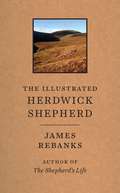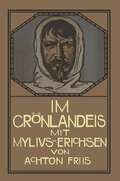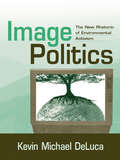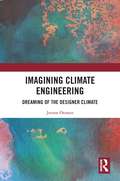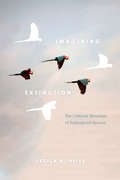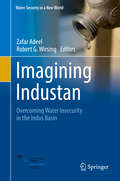- Table View
- List View
An Illustrated Guide to Furniture History
by Joclyn M. OatsAn Illustrated Guide to Furniture History provides upper-level students and instructors with an alternative visual analytical approach to learning about furniture history from Antiquity to Postmodernism. Following an immersive teaching model, it presents a Nine-Step Methodology to help students strengthen their visual literacy and quickly acquire subject area knowledge. Moving chronologically through key periods in furniture history and interior design, such as the Renaissance, the Arts and Crafts Movement, and Modernism, it traverses Europe to America to present a comprehensive foundational guide to the history of furniture design. Part I addresses furniture within the context of the built environment, with chapters exploring the historical perspective, construction principles, and the categorization of furniture. In Part II, the author visually depicts the structural organization of the methodological process, a three-category framework: History, Aesthetics, and Visual Notes. The chapters in this part prepare the reader for the visual analysis that will occur in the final section of the book. The book is lavishly illustrated in full color with over 300 images to reinforce visual learning and notation. A must-have reference and study guide for students in industrial and product design, interior design, and architecture.
The Illustrated Guide to Pigs: How To Choose Them - How To Keep Them
by Celia LewisThe Illustrated Guide to Pigs covers the 35 most familiar breeds of pigs in Europe and North America. The breed profiles are written in engaging text that covers the history of each breed, its main characteristics and information about how to look after them. Each breed has been illustrated with delightful paintings by the author.Introductory sections contain practical advice about pig-rearing and husbandry, and outline the differences between breeds, including the pros and cons of keeping pure breeds and cross breeds. Whether you're looking to raise your own pigs or simply love these intelligent and endearing animals, this book is a must-have.
The Illustrated Herdwick Shepherd
by James RebanksI am the luckiest man alive, because I get to live and work in the most beautiful place on earth: Matterdale in the English Lake District.When I was a child we didn't really go anywhere, except a week in the Isle of Man when I was about ten years old, and I never left Britain until I was twenty.Even now, years later, the best bit of any travelling is coming home. Bringing us into the world of shepherd's baking competitions, sheep shows and moments out on the fell watching the sheep run away home, James Rebanks interweaves thoughts and reflections on the art of shepherding with his photographs of the valley, people and animals that make up the daily life of the fells. A life lived by the three hundred surviving fell farming families, this is a book of photos and words filled with reverence and love.
The Illustrated History of Natural Disasters
by Jan Kozák Vladimir CermákThis book tells the story of the Earth itself, explaining the interplay of its gradual geologi- levolution, presented as a generally slow and safe process, with the sudden manifestations of natural hazards, which involve disasters that affect the environment and lead to huge material damage and human losses. The natural forces at play, whether they are violent explosions ofvolcanic eruptions or almost imperceptible deformations of subsurface rock strata, nally- sulting in devastating earthquakes, all control the existence and destiny of a certain part of the global population. The development of man’s existence down through history has depended upon his understanding of the world in which he lives, and upon his ability to turn to his own best use the materials that were there for the taking. However, he has had not only to furnish himself with food, water, building materials, and energy to protect himself against occasional natural adversities. Protecting himself from them meant comprehending their causes, and the essential core of his understanding was in recording and depicting them. This book is written for anyone interested in the Earth in general, and in natural disasters in particular, presenting a unique collection of historical illustrations of volcanic eruptions and earthquake events and their repercussions. The book represents a golden mean between sci- ti c and popular works.
Im Fokus: Reise in die unbekannten Tiefen der Ozeane (Naturwissenschaften im Fokus)
by Nadja Podbregar Dieter Lohmann"Dorthin zu gehen, wo noch kein Mensch gewesen ist“ – das ist nicht nur das Motto der Science-Fiction-Serie Star Trek, sondern auch das der meisten Meereswissenschaftler. Denn noch immer sind große Teile dieses gewaltigen Lebensraums nahezu unerforscht. Nur allmählich beginnt sich der Schleier des Geheimnisses zu lüften. So ist Biologen nicht nur die erste Volkszählung in den Ozeanen gelungen, Geowissenschaftler haben auch mithilfe moderner Tauchroboter ebenso bizarre wie aufregende Phänomene in der Tiefsee entdeckt. Seltsame Asphaltvulkane gehören genauso dazu, wie brodelnde Geysire und sogar Korallen in nachtdunkler Schwärze. Das Buch stellt die exotischen Wunderwelten unserer Ozeane ausführlich vor. Es erklärt aber auch, wie sie entstanden sind und warum manche von ihnen in Gefahr sind.
Im Fokus: Zerstörerische Gewalten und tickende Zeitbomben (Naturwissenschaften im Fokus)
by Nadja Podbregar Dieter LohmannErdbeben, Hurrikans, Jahrhunderthochwasser: Immer wieder zeigt die Natur in solchen Ereignissen auch ihre zerstörerische Seite – und dies seit Jahrmillionen. Naturkatastrophen haben auch unsere eigene Geschichte geprägt und beeinflusst: Sie schufen Mythen, entschieden Kriege und ließen ganze Reiche untergehen. Und selbst heute – trotz aller Fortschritte in Wissenschaft und Technologie – gehören diese Naturereignisse noch immer zu den Phänomenen unseres Planeten, die für uns unbeherrschbar und oft auch unvorhersehbar sind.Was aber macht Erdbeben und Co so unberechenbar? Warum gibt es Tornados auch bei uns? Und wie wird der Klimawandel künftige Naturgefahren beeinflussen? Welche Antworten es bisher auf diese und andere Fragen gibt – und auch was wir heute noch nicht wissen, beschreibt dieses Buch. Es gibt einen Überblick über die großen Naturkatastrophen unseres Planeten und erklärt die Hintergründe.Naturwissenschaften im Fokus Reihenherausgeber: Harald Frater
Im Grönlandeis mit Mylius-Erichsen: Die Danmark-Expedition 1906–1908
by Achton Friis Friedrich StichertDieser Buchtitel ist Teil des Digitalisierungsprojekts Springer Book Archives mit Publikationen, die seit den Anfängen des Verlags von 1842 erschienen sind. Der Verlag stellt mit diesem Archiv Quellen für die historische wie auch die disziplingeschichtliche Forschung zur Verfügung, die jeweils im historischen Kontext betrachtet werden müssen. Dieser Titel erschien in der Zeit vor 1945 und wird daher in seiner zeittypischen politisch-ideologischen Ausrichtung vom Verlag nicht beworben.
Im Hürdenlauf zur Energiewende: Von Transformationen, Reformen und Innovationen
by Achim Brunnengräber Maria Rosaria Di NucciDer Begriff der Energiewende wird bei seinem Lauf um die Welt nicht übersetzt. Er weist auf die Dringlichkeit der Umstellung der Energieversorgung bei Strom, Wärme und Mobilität durch erneuerbare Energien hin. Schneller als von vielen erwartet hat die Energiewende vor allem im Strombereich ein Ausbautempo erreicht, mit dem viele nicht gerechnet hatten. Sie ist allerdings keine freiwillige Maßnahme, sondern wird durch die Krisenhaftigkeit von nicht nachhaltigen Produktions- und Lebensweisen erzwungen. Sie ist auch kein Selbstläufer. Die vielfältigen neuen Initiativen, Maßnahmen und Programme befinden sich im Wettbewerb mit einem alten, fossilen und nuklearen Energiesystem. Von den Hürden, die in diesem Wettlauf bereits genommen wurden, vom Tempo des Ausbaus, von Innovationen sowie von den notwendigen Reformen und vielfältigen Herausforderungen der Energiewende handelt dieses Buch.
Image and Environment: Cognitive Mapping and Spatial Behavior
by Roger M. Downs David SteaCognitive mapping is a construct that encompasses those processes that enable people to acquire, code, store, recall, and manipulate information about the nature of their spatial environment. It refers to the attributes and relative locations of people and objects in the environment, and is an essential component in the adaptive process of spatial decision-making--such as finding a safe and quick route to from work, locating potential sites for a new house or business, and deciding where to travel on a vacation trip.Cognitive processes are not constant, but undergo change with age or development and use or learning. Image and Environment, now in paperback, is a pioneer study. It brings a new academic discipline to a wide audience. The volume is divided into six sections, which represent a comprehensive breakdown of cognitive mapping studies: "Theory"; "Cognitive Representations"; "Spatial Preferences"; "The Development of Spatial Cognition"; "Geographical and Spatial Orientation"; and "Cognitive Distance." Contributors include Edward Tolman, James Blaut, Stephen Kaplan, Terence Lee, Donald Appleyard, Peter Orleans, Thomas Saarinen, Kevin Cox, Georgia Zannaras, Peter Gould, Roger Hart, Gary Moore, Donald Griffin, Kevin Lynch, Ulf Lundberg, Ronald Lowrey, and Ronald Briggs.
Image and Environment: Cognitive Mapping and Spatial Behavior
by David SteaCognitive mapping is a construct that encompasses those processes that enable people to acquire, code, store, recall, and manipulate information about the nature of their spatial environment. It refers to the attributes and relative locations of people and objects in the environment, and is an essential component in the adaptive process of spatial decision-making--such as finding a safe and quick route to from work, locating potential sites for a new house or business, and deciding where to travel on a vacation trip.Cognitive processes are not constant, but undergo change with age or development and use or learning. Image and Environment, now in paperback, is a pioneer study. It brings a new academic discipline to a wide audience. The volume is divided into six sections, which represent a comprehensive breakdown of cognitive mapping studies: "Theory"; "Cognitive Representations"; "Spatial Preferences"; "The Development of Spatial Cognition"; "Geographical and Spatial Orientation"; and "Cognitive Distance." Contributors include Edward Tolman, James Blaut, Stephen Kaplan, Terence Lee, Donald Appleyard, Peter Orleans, Thomas Saarinen, Kevin Cox, Georgia Zannaras, Peter Gould, Roger Hart, Gary Moore, Donald Griffin, Kevin Lynch, Ulf Lundberg, Ronald Lowrey, and Ronald Briggs.
Image Politics: The New Rhetoric of Environmental Activism (Revisioning Rhetoric Ser.)
by Kevin Michael DeLucaThis exceptional volume examines “image events” as a rhetorical tactic utilized by environmental activists. Author Kevin Michael DeLuca analyzes widely televised environmentalist actions in depth to illustrate how the image event fulfills fundamental rhetorical functions in constructing and transforming identities, discourses, communities, cultures, and world views. Image Politics also exhibits how such events create opportunities for a politics that does not rely on centralized leadership or universal metanarratives. The book presents a rhetoric of the visual for our mediated age as it illuminates new political possibilities currently enacted by radical environmental groups. Chapters in the volume cover key areas of environmental activism such as:*The rhetoric of social movements;*Imaging social movements;*Environmental justice groups; and*Participatory democracy. This book is of interest to scholars and students of rhetorical theory, media and communication theory, visual theory, environmental studies, social change movements, and political theory. It will also appeal to others interested in ecology, radical environmental politics, and activism, and is an excellent supplemental text in advanced undergraduate and graduate level courses in these areas.
Image Politics: The New Rhetoric of Environmental Activism
by Kevin Michael DeLucaThis exceptional volume examines “image events” as a rhetorical tactic utilized by environmental activists. Author Kevin Michael DeLuca analyzes widely televised environmentalist actions in depth to illustrate how the image event fulfills fundamental rhetorical functions in constructing and transforming identities, discourses, communities, cultures, and world views. Image Politics also exhibits how such events create opportunities for a politics that does not rely on centralized leadership or universal metanarratives. The book presents a rhetoric of the visual for our mediated age as it illuminates new political possibilities currently enacted by radical environmental groups. Chapters in the volume cover key areas of environmental activism such as:*The rhetoric of social movements;*Imaging social movements;*Environmental justice groups; and*Participatory democracy. This book is of interest to scholars and students of rhetorical theory, media and communication theory, visual theory, environmental studies, social change movements, and political theory. It will also appeal to others interested in ecology, radical environmental politics, and activism, and is an excellent supplemental text in advanced undergraduate and graduate level courses in these areas.
Imagining Apocalyptic Politics in the Anthropocene (Routledge Environmental Humanities)
by Earl T. HarperBringing together scholars from English literature, geography, politics, the arts, environmental humanities and sociology, Imagining Apocalyptic Politics in the Anthropocene contributes to the emerging debate between bodies of thought first incepted by scholars such as Mouffe, Whyte, Kaplan, Hunt, Swyngedouw and Malm about how apocalyptic events, narratives and imaginaries interact with societal and individual agency historically and in the current political moment. Exploring their own empirical and philosophical contexts, the authors examine the forms of political acting found in apocalyptic imaginaries and reflect on what this means for contemporary society. By framing their arguments around either pre-apocalyptic, peri-apocalyptic or post-apocalyptic narratives and events, a timeline emerges throughout the volume which shows the different opportunities for political agency the anthropocenic subject can enact at the various stages of apocalyptic moments. Featuring a number of creative interventions exclusively produced for the work from artists and fiction writers who engage with the themes of apocalypse, decline, catastrophe and disaster, this innovative book will be of great interest to students and scholars of the politics of climate change, the environmental humanities, literary criticism and eco-criticism.
Imagining Apocalyptic Politics in the Anthropocene (Routledge Environmental Humanities)
by Earl T. Harper Doug SpechtBringing together scholars from English literature, geography, politics, the arts, environmental humanities and sociology, Imagining Apocalyptic Politics in the Anthropocene contributes to the emerging debate between bodies of thought first incepted by scholars such as Mouffe, Whyte, Kaplan, Hunt, Swyngedouw and Malm about how apocalyptic events, narratives and imaginaries interact with societal and individual agency historically and in the current political moment. Exploring their own empirical and philosophical contexts, the authors examine the forms of political acting found in apocalyptic imaginaries and reflect on what this means for contemporary society. By framing their arguments around either pre-apocalyptic, peri-apocalyptic or post-apocalyptic narratives and events, a timeline emerges throughout the volume which shows the different opportunities for political agency the anthropocenic subject can enact at the various stages of apocalyptic moments. Featuring a number of creative interventions exclusively produced for the work from artists and fiction writers who engage with the themes of apocalypse, decline, catastrophe and disaster, this innovative book will be of great interest to students and scholars of the politics of climate change, the environmental humanities, literary criticism and eco-criticism.
Imagining Climate Engineering: Dreaming of the Designer Climate
by Jeroen OomenThis book highlights the increasing attention for climate engineering, a set of speculative technologies aimed to counter global warming. What is the future of the global climate? And who gets to decide—or even design—this future? Imagining Climate Engineering explores how and why climate engineering became a potential approach to anthropogenic climate change. Specifically, it showcases how views on the future of climate change and climate engineering evolved by addressing the ways in which climate engineers view its respective physical, political, and moral domains. Tracing the intellectual and political history of dreams to control the weather and climate as well as the discovery of climate change, Jeroen Oomen examines the imaginative parameters within which contemporary climate engineering research takes place. Introducing the analytical metaphor ‘ways of seeing’ to describe explicit or implicit visions, understandings, and foci that facilitate a particular understanding of what is at stake, Imagining Climate Engineering shows how visions on the knowability of climate tie into moral and political convictions about the possibility and desirability of engineering the climate. Marrying science and technology studies and the environmental humanities, Oomen provides crucial insights for the future of the climate change debate for scholars and students.
Imagining Climate Engineering: Dreaming of the Designer Climate
by Jeroen OomenThis book highlights the increasing attention for climate engineering, a set of speculative technologies aimed to counter global warming. What is the future of the global climate? And who gets to decide—or even design—this future? Imagining Climate Engineering explores how and why climate engineering became a potential approach to anthropogenic climate change. Specifically, it showcases how views on the future of climate change and climate engineering evolved by addressing the ways in which climate engineers view its respective physical, political, and moral domains. Tracing the intellectual and political history of dreams to control the weather and climate as well as the discovery of climate change, Jeroen Oomen examines the imaginative parameters within which contemporary climate engineering research takes place. Introducing the analytical metaphor ‘ways of seeing’ to describe explicit or implicit visions, understandings, and foci that facilitate a particular understanding of what is at stake, Imagining Climate Engineering shows how visions on the knowability of climate tie into moral and political convictions about the possibility and desirability of engineering the climate. Marrying science and technology studies and the environmental humanities, Oomen provides crucial insights for the future of the climate change debate for scholars and students.
Imagining Extinction: The Cultural Meanings of Endangered Species
by Ursula K. HeiseWe are currently facing the sixth mass extinction of species in the history of life on Earth, biologists claim—the first one caused by humans. Activists, filmmakers, writers, and artists are seeking to bring the crisis to the public’s attention through stories and images that use the strategies of elegy, tragedy, epic, and even comedy. Imagining Extinction is the first book to examine the cultural frameworks shaping these narratives and images. Ursula K. Heise argues that understanding these stories and symbols is indispensable for any effective advocacy on behalf of endangered species. More than that, she shows how biodiversity conservation, even and especially in its scientific and legal dimensions, is shaped by cultural assumptions about what is valuable in nature and what is not. These assumptions are hardwired into even seemingly neutral tools such as biodiversity databases and laws for the protection of endangered species. Heise shows that the conflicts and convergences of biodiversity conservation with animal welfare advocacy, environmental justice, and discussions about the Anthropocene open up a new vision of multispecies justice. Ultimately, Imagining Extinction demonstrates that biodiversity, endangered species, and extinction are not only scientific questions but issues of histories, cultures, and values.
Imagining Extinction: The Cultural Meanings of Endangered Species
by Ursula K. HeiseWe are currently facing the sixth mass extinction of species in the history of life on Earth, biologists claim—the first one caused by humans. Activists, filmmakers, writers, and artists are seeking to bring the crisis to the public’s attention through stories and images that use the strategies of elegy, tragedy, epic, and even comedy. Imagining Extinction is the first book to examine the cultural frameworks shaping these narratives and images. Ursula K. Heise argues that understanding these stories and symbols is indispensable for any effective advocacy on behalf of endangered species. More than that, she shows how biodiversity conservation, even and especially in its scientific and legal dimensions, is shaped by cultural assumptions about what is valuable in nature and what is not. These assumptions are hardwired into even seemingly neutral tools such as biodiversity databases and laws for the protection of endangered species. Heise shows that the conflicts and convergences of biodiversity conservation with animal welfare advocacy, environmental justice, and discussions about the Anthropocene open up a new vision of multispecies justice. Ultimately, Imagining Extinction demonstrates that biodiversity, endangered species, and extinction are not only scientific questions but issues of histories, cultures, and values.
Imagining Extinction: The Cultural Meanings of Endangered Species
by Ursula K. HeiseWe are currently facing the sixth mass extinction of species in the history of life on Earth, biologists claim—the first one caused by humans. Activists, filmmakers, writers, and artists are seeking to bring the crisis to the public’s attention through stories and images that use the strategies of elegy, tragedy, epic, and even comedy. Imagining Extinction is the first book to examine the cultural frameworks shaping these narratives and images. Ursula K. Heise argues that understanding these stories and symbols is indispensable for any effective advocacy on behalf of endangered species. More than that, she shows how biodiversity conservation, even and especially in its scientific and legal dimensions, is shaped by cultural assumptions about what is valuable in nature and what is not. These assumptions are hardwired into even seemingly neutral tools such as biodiversity databases and laws for the protection of endangered species. Heise shows that the conflicts and convergences of biodiversity conservation with animal welfare advocacy, environmental justice, and discussions about the Anthropocene open up a new vision of multispecies justice. Ultimately, Imagining Extinction demonstrates that biodiversity, endangered species, and extinction are not only scientific questions but issues of histories, cultures, and values.
Imagining Extinction: The Cultural Meanings of Endangered Species
by Ursula K. HeiseWe are currently facing the sixth mass extinction of species in the history of life on Earth, biologists claim—the first one caused by humans. Activists, filmmakers, writers, and artists are seeking to bring the crisis to the public’s attention through stories and images that use the strategies of elegy, tragedy, epic, and even comedy. Imagining Extinction is the first book to examine the cultural frameworks shaping these narratives and images. Ursula K. Heise argues that understanding these stories and symbols is indispensable for any effective advocacy on behalf of endangered species. More than that, she shows how biodiversity conservation, even and especially in its scientific and legal dimensions, is shaped by cultural assumptions about what is valuable in nature and what is not. These assumptions are hardwired into even seemingly neutral tools such as biodiversity databases and laws for the protection of endangered species. Heise shows that the conflicts and convergences of biodiversity conservation with animal welfare advocacy, environmental justice, and discussions about the Anthropocene open up a new vision of multispecies justice. Ultimately, Imagining Extinction demonstrates that biodiversity, endangered species, and extinction are not only scientific questions but issues of histories, cultures, and values.
Imagining Extinction: The Cultural Meanings of Endangered Species
by Ursula K. HeiseWe are currently facing the sixth mass extinction of species in the history of life on Earth, biologists claim—the first one caused by humans. Activists, filmmakers, writers, and artists are seeking to bring the crisis to the public’s attention through stories and images that use the strategies of elegy, tragedy, epic, and even comedy. Imagining Extinction is the first book to examine the cultural frameworks shaping these narratives and images. Ursula K. Heise argues that understanding these stories and symbols is indispensable for any effective advocacy on behalf of endangered species. More than that, she shows how biodiversity conservation, even and especially in its scientific and legal dimensions, is shaped by cultural assumptions about what is valuable in nature and what is not. These assumptions are hardwired into even seemingly neutral tools such as biodiversity databases and laws for the protection of endangered species. Heise shows that the conflicts and convergences of biodiversity conservation with animal welfare advocacy, environmental justice, and discussions about the Anthropocene open up a new vision of multispecies justice. Ultimately, Imagining Extinction demonstrates that biodiversity, endangered species, and extinction are not only scientific questions but issues of histories, cultures, and values.
Imagining Extinction: The Cultural Meanings of Endangered Species
by Ursula K. HeiseWe are currently facing the sixth mass extinction of species in the history of life on Earth, biologists claim—the first one caused by humans. Activists, filmmakers, writers, and artists are seeking to bring the crisis to the public’s attention through stories and images that use the strategies of elegy, tragedy, epic, and even comedy. Imagining Extinction is the first book to examine the cultural frameworks shaping these narratives and images. Ursula K. Heise argues that understanding these stories and symbols is indispensable for any effective advocacy on behalf of endangered species. More than that, she shows how biodiversity conservation, even and especially in its scientific and legal dimensions, is shaped by cultural assumptions about what is valuable in nature and what is not. These assumptions are hardwired into even seemingly neutral tools such as biodiversity databases and laws for the protection of endangered species. Heise shows that the conflicts and convergences of biodiversity conservation with animal welfare advocacy, environmental justice, and discussions about the Anthropocene open up a new vision of multispecies justice. Ultimately, Imagining Extinction demonstrates that biodiversity, endangered species, and extinction are not only scientific questions but issues of histories, cultures, and values.
Imagining Industan: Overcoming Water Insecurity in the Indus Basin (Water Security in a New World)
by Zafar Adeel Robert G. WirsingThis volume calls upon over a dozen Indus observers to imagine a scenario for the Indus basin in which transboundary cooperation over water resources overcomes the insecurity arising from water dependence and scarcity. From diverse perspectives, its essays examine the potential benefits to be gained from revisiting the 1960 Indus Waters Treaty, as well as from mounting joint efforts to increase water supply, to combat climate change, to develop hydroelectric power, and to improve water management.The Indus basin is shared by four countries (Afghanistan, China, India, and Pakistan). The basin’s significance stems in part simply from the importance of these countries, three of them among the planet’s most populous states, one of them boasting the world’s second largest economy, and three of them members of the exclusive nuclear weapons club. However, the basin’s significance stems also from the great importance of the Indus waters themselves – due especially to the region’s massive dependence on irrigated agriculture as well as to the menace of climate change and advancing water scarcity. The “Industan” this volume imagines is a definite departure from business as usual responses to the Indus basin’s emerging fresh water crisis. The objective is to kindle serious discussion of the cooperation needed to confront what many water experts believe is developing into one of the planet’s most gravely threatened river basins. It is thus both assessment of the current state of play in regard to water security in the Indus basin and recommendation about where to go from here.
Imagining Sustainability: Creative urban environmental governance in Chicago and Melbourne (Routledge Research in Sustainable Urbanism)
by Julie CidellCities, rather than nations, have become the key sites for enacting environmental policies. This is due to the combination of growing urban populations and increased action on the part of local governments (generally attributed to national governments’ failure to act on climate change). Imagining Sustainability seeks to understand how actors in local government conceptualize sustainability and their role in producing it, and what difference that understanding makes to their physical, political, and social environments now and in the future. International comparisons can uncover new ideas and possibilities. Chicago and Melbourne are prime candidates for such a comparison: they are cities of the same age, they have similar historical trajectories as interior gateways followed by industrial growth and then deindustrialization, and they have demonstrated the same recent desire to be global champions of sustainability. Based on qualitative fieldwork in these two cities, this book uses Karen Barad’s methodology of diffraction to read these case studies through each other. This methodology helps to understand not only what differences exist between these two places, but what effects those differences have on the urban environment. This book will be of great interest to students and scholars of urban studies, urban planning and environmental policy and governance.
Imagining Sustainability: Creative urban environmental governance in Chicago and Melbourne (Routledge Research in Sustainable Urbanism)
by Julie CidellCities, rather than nations, have become the key sites for enacting environmental policies. This is due to the combination of growing urban populations and increased action on the part of local governments (generally attributed to national governments’ failure to act on climate change). Imagining Sustainability seeks to understand how actors in local government conceptualize sustainability and their role in producing it, and what difference that understanding makes to their physical, political, and social environments now and in the future. International comparisons can uncover new ideas and possibilities. Chicago and Melbourne are prime candidates for such a comparison: they are cities of the same age, they have similar historical trajectories as interior gateways followed by industrial growth and then deindustrialization, and they have demonstrated the same recent desire to be global champions of sustainability. Based on qualitative fieldwork in these two cities, this book uses Karen Barad’s methodology of diffraction to read these case studies through each other. This methodology helps to understand not only what differences exist between these two places, but what effects those differences have on the urban environment. This book will be of great interest to students and scholars of urban studies, urban planning and environmental policy and governance.


